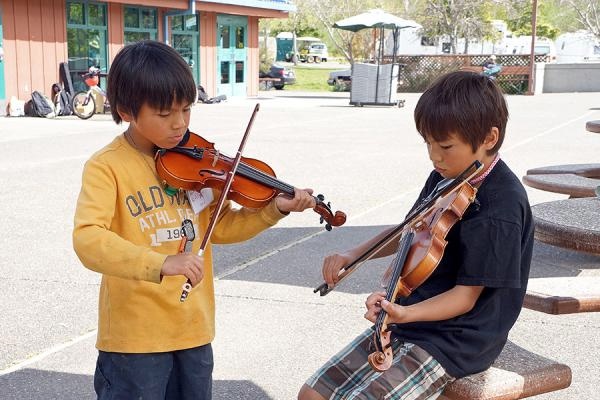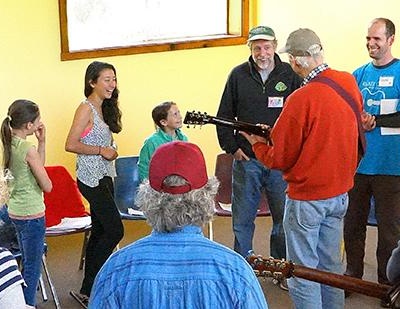 Fiddling brothers practice their craft. (photo by Peter Oppenheimer)
Fiddling brothers practice their craft. (photo by Peter Oppenheimer)
Music With Older Kids
Multigenerational Music Making
by Nanci Schneidinger and Hassaun A. Jones-Bey
Two years ago, Ingrid Noyes launched a four-day, multigenerational Walker Creek Music Camp at the Walker Creek Ranch in Western Marin County, California,
twice a year (in spring and fall). This interview isn’t so much about the camp as it is about the role that CMN membership has played in bringing
Ingrid’s professional skills and confidence to the point of successfully including such a—still challenging—venture amongst the many other activities
and pursuits in a busy and diverse musical life.
PIO!: You said the administrative role in running this music camp is something new for you?
IN: This has been a big change for me and a huge learning curve as I navigate my way through running my own business. I've always worked
freelance, but always avoided anything that would require me to have to deal with very much administrative work, such as building and maintaining a website,
taking payments on line, issuing 1099 tax forms, and so on. After the first couple of years, I realized I’m doing an administrative job I have no
real training for, and I'm just now in the process of hiring a director’s assistant to help me do the desk work that I (a) don’t like and (b)
am not very good at.
PIO!: So what induced you to get into it?
IN: My experience with directing three CMN conferences at Walker Creek Ranch gave me the confidence to take on this project in the first
place. I joined CMN shortly after I started working extensively with kids and music. I was so happy to find CMN! It was a little blurb that Faith Petric
included in the Folknik newsletter of the San Francisco Folk Music Club, that I happened to see at the right time. A few years later, Bob Blue
from CMN asked if I would be willing to coordinate a conference and I said sure. That is a big job, and I learned a lot from doing it. I coordinated two
more after that, both of those with Joanne Tuller, a.k.a. JT, as co-coordinator, before I told the board that it was someone else’s turn.
 A multigenerational class focuses on vocal duets. (photo by Peter Oppenheimer)
A multigenerational class focuses on vocal duets. (photo by Peter Oppenheimer)
It was after I had coordinated the first of those conferences that a friend of mine, who was at an International Bluegrass Music Association conference
back east, told a board member of the California Bluegrass Association (CBA) of his dream to start a music camp for bluegrass players and his search for
someone who could be the director and put the whole thing together. The CBA board member knew about my coordinating those CMN conferences and suggested
that my friend talk to me, and that’s what led me into the world of producing bluegrass camps. So this is just one of many ways that being involved
with CMN has influenced my life in a big way. Many of my best friendships, and much of my work, has grown out of CMN connections. It’s been amazing.
I left the CBA about three years ago to start running my own camps, but the camp I started for them continues under new leadership (in Grass Valley,
California), while I’m now running my own two camps each year at Walker Creek Ranch.
PIO!: Your association with CMN has influenced the way you run the camp as well?
IN: It’s CMN’s example that has taught me so much about inclusiveness and making everyone feel welcome. I tell my jam leaders
at camp to make sure everyone who walks in the door gets greeted and welcomed and made room for, which comes straight out of my CMN gathering experiences
of opening the circle. I think it’s a big reason why so many people tell me that my camp is the best one they’ve been to, with the best vibe,
where they can come in knowing no one but feel immediately welcome and leave with many new friends.
I also have come to place a huge value on multigenerationalism, of mixing old people and young people all together. So though we do have a class just for
the littlest ones (the Music & More class for children aged ten and younger), there are other kids at camp who are just mixed in with the adults in
the main classes. So, there will often be, for example, a fiddle class with students ranging in age from eight to eighty. The kids inspire the adults with
their talent and enthusiasm, and the adults model respectful classroom behavior for the kids.
I think this also comes from my early years in life, starting school at a one-room schoolhouse. It was the only school I ever liked going to, because it
felt like a family and a community—the older kids helping the younger ones, and so on. When they closed that school and I found myself in a fifth grade
class with twenty other ten-year-olds, the feeling changed markedly to one of competitiveness and teasing. And after that I hated school. I don’t
think the way we so often segregate our kids and ourselves by age, including the way we run our schools, is a natural or healthy way to live.
So I place a big value on including children and adults all in the same classes, once the kids are old enough to sit through a class that’s largely
paced to an adult attention span. I tell the younger kids to take breaks if they need to, and I tell the teaching assistants to look out for them, and it
works. It’s still largely an adult camp, but typically about 10 to 20 percent of the campers are kids, and I’m always doing all I can to
bring in more kids and young adults. That means, in a big way, finding as much scholarship funding as possible, since families often need financial
assistance to get themselves to camp.
PIO!: It seems like the major influence from CMN that also fits in with your life experiences is one of inclusiveness.
IN: Yes. It’s also the idea of inclusiveness that led me to expand the original “strictly bluegrass” focus of the camp
to include, from the very beginning, traditional old-time music as well, which is what bluegrass music grew out of, and then along the way to add bits of
related genres like swing, country, and Celtic—not too much, because I don’t want too many different styles all trying to get along at the same camp,
but enough to give it variety and a full curriculum that appeals to a broad range of people.
My connection to CMN and all my experiences with CMN have led me to, and prepared me for, and helped me excel at, the work that I’m now doing. It,
like the work CMN does, is about helping people enjoy life through music, but I’m working with both kids and adults now instead of just kids. I would
like to increase the kid-adult ratio at camp; that is something I’m always working towards. So, although I’m less directly involved with
CMN than I used to be, the organization continues to influence and help me in my own musical teaching and directing endeavors. It’s really been
amazing to what extent this one organization has shaped my life. Thank you, CMN. 